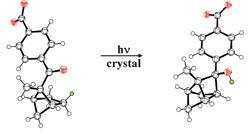Chemists from Canada have found a new way to perform asymmetric catalysis - in a crystal.
Chemists from Canada have found a new way to perform asymmetric catalysis - in a crystal.

John Scheffer and his team at the University of British Columbia have shown that certain types of organic compounds can be organised in a crystal to undergo reactions that give up to 90 per cent of one mirror image form (enantiomer) of the product. This is important since different forms of the same drug can give widely different properties.
Scheffer’s team used a compound in which a single conformational isomer crystallises more favourably, which was then transformed into a permanently chiral molecule by UV light - all in the solid state.
The problem in the past has been that spontaneously separating isomers by crystallisation is rare and unpredictable. This method rectifies this and allows ’virtually any carboxylic acid to be engineered as a single-enantiomer crystalline solid capable of taking part in an asymmetric synthesis,’ said Scheffer.
The researchers hope to enlarge the scope of the method by extending it to non-ionic species ’that could be attached to reactive substrates,’ and to ’some of the very large number of reactions that occur in the absence of light’. So, for this solid state ionic chiral auxiliary method of asymmetric synthesis, as Scheffer terms it, the future is dark.
Neil D Withers
References
W Xia, J R Scheffer and B O Patrick, CrystEngComm, 2005, 7(119), 728-730 (DOI: 10.1039/<MAN>b514952e</MAN>)






No comments yet